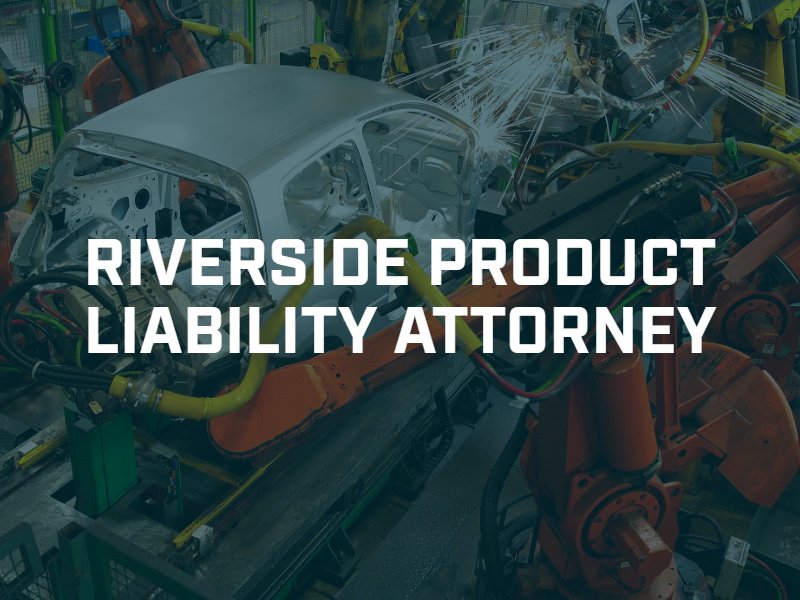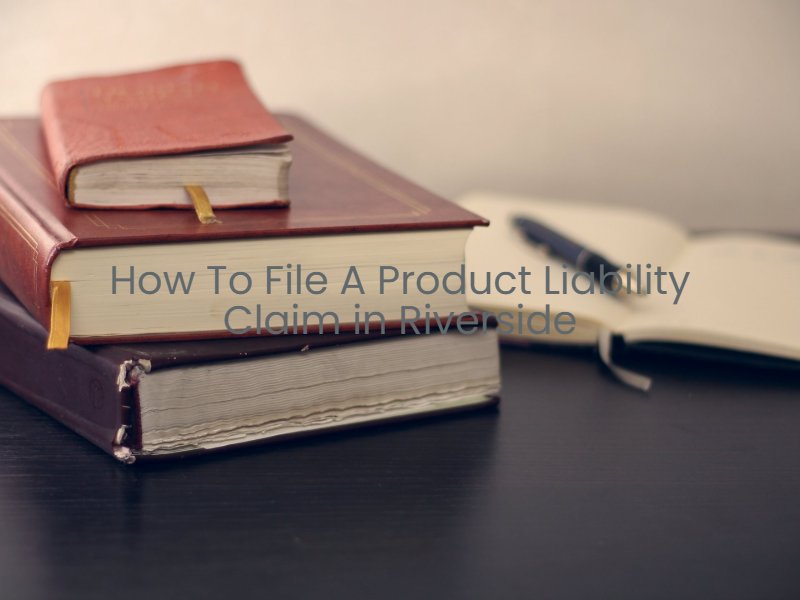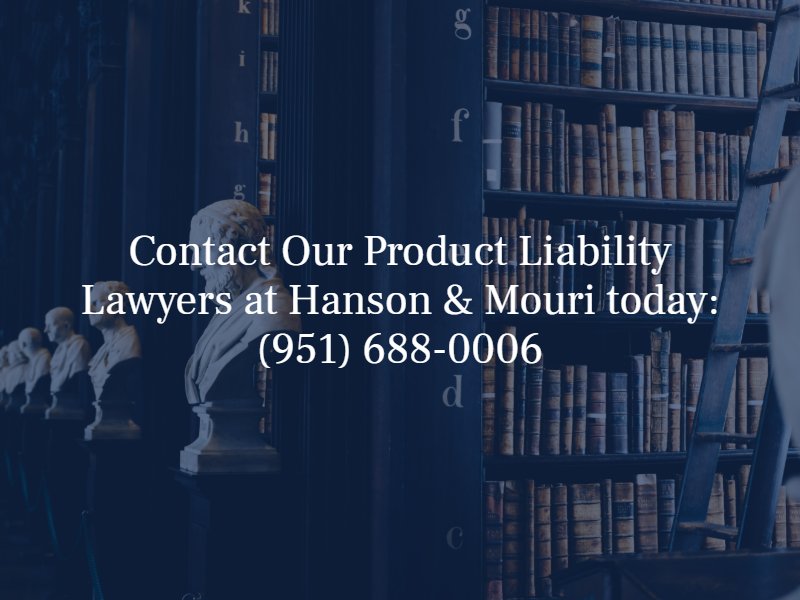
Riverside Product Liability Lawyer
CLICK FOR FREE CONSULTATION
Despite consumer protection laws designed to safeguard the public, thousands of people are injured in the U.S. every year by dangerous products on the market. Individuals get hurt when manufactures place profit over safety. If you or your loved one has been injured by a dangerous product, contact the law firm of Hanson & Mouri in Riverside County, CA today. You may have a product liability claim for compensation.
Why Choose Us?
- Our dedicated legal team of Riverside product liability lawyer is committed to giving every client we represent the focus and undivided attention he or she deserves.
- We are compassionate and care for our clients. If you have been injured by a dangerous product, we will treat you like family and give you our commitment to aggressively fight for your rights and the compensation you deserve.
- We are seasoned litigators and effective advocates who will actually take your case to court if necessary. We know that larger settlements come with being prepared to try cases.
What Is Product Liability?
Product liability is the legal liability a manufacturer or distributor incurs for producing or selling a defective product. The term refers to liability of any or all parties along the chain of manufacture of a product for damage caused by that product. Products that contain inherent defects that cause harm to consumers are the subject of product liability claims.
Negligence vs Strict Liability in Product Liability Cases
In Southern California, product liability lawsuits can be based on either of two main legal theories – negligence and strict liability.
Negligence
A product liability civil action brought on the grounds of negligence requires the injured party to prove negligence of the defendant in the creation or manufacture of the product. Negligence can be defined as any failure to act that causes the individual or entity to breach its duties of care to consumers. The company may have been negligent in any of various areas, such as manufacturing regulations, safety protocols, or training procedures, which resulted in defective consumer products.
Strict Liability
Under strict liability laws, an injured party can sue for damages without proving the manufacturer’s negligence. The defendant will be liable for damages caused by the defective product, regardless of negligence, if the product has one of the three main product defects.
What are Types of Product Defects?
The three main types of product defects are:
- Design defects: Design flaws are mistakes the company makes inherent in the design of the product before it is manufactured.
- Manufacturing defects: These defects are mistakes in manufacturing or assembly that make an otherwise safe product dangerous.
- Marketing defects: This type of product defect is a failure to warn of known hazards or provide adequate instructions for the use of the product.
Types Of Injuries From Defective Products
Defective products can cause any injury and may range from mild to catastrophic. Some of the most common that occur and are grounds for a claim include:
Choking Injuries
Especially common among children and are sometimes fatal. Many toys have small parts that can easily break off, and if a child sticks a small part in their mouth, they can choke. Many of these injuries or deaths are due to toys not having warning labels that they are a choking hazard and only for children of a certain age.
Burn Injuries
Defective household appliances, like hairdryers, curling irons, or toasters, can have faulty wiring, increasing the risk of them bursting into flames or causing electric shock. A severe burn injury can be excruciating and may cause infection, disfigurement, and other complications.
Dangerous Drug Injuries
Drug companies negligently rush drugs to market before receiving safety approval from the Food and Drug Administration (FDA), which can cause severe temporary or permanent physical harm to consumers, such as cardiac arrest, heart liver, or kidney failure, lung problems, brain damage, or wrongful death.
Broken Bones
Any product that unexpectedly breaks can cause severe bone fractures. For example, a fall from a faulty ladder, a child falling from a defective high chair, a poorly manufactured bookcase falling onto someone, etc. Broken bones can be incredibly painful and may require surgery and a lengthy recovery.
Internal Damage
Medical devices, such as surgical mesh, pacemakers, and hip replacements, can malfunction or fail and cause far more debilitating injuries than the condition they were intended to cure. Patients may experience internal damage and tremendous pain. They may be forced to go through multiple surgical procedures to repair or replace a defective device.
Other severe injuries suffered by defective products consumers include strangulation, poisoning, traumatic brain injury, neck and back injuries, spinal cord injuries, paralysis, loss of vision or hearing, loss of limbs or digits, and coma. However, no matter the type or severity, your injury may entitle you to compensation when a defective product is involved.
Common Products Involved in Product Liability Claims
The following products are commonly involved in product liability lawsuits. However, any product has the potential to be dangerous if it is defective.
- Cars: Although vehicles must pass extensive safety testing before being put on the market, they are still among the most recalled products. Any minor defect can have catastrophic consequences.
- Children’s Toys: Many children’s toys are inherently dangerous due to their design, especially those with small parts.
- Prescription Drugs: Some drugs have unknown side effects, unfortunately, until patients begin taking the medication.
- Medical Devices: implants or devices used by medical practitioners can fail and cause significant harm.
- Household Appliances: Common culprits include faulty clothes dryers, water heaters, hairdryers, toasters, and kitchen ranges but almost any household appliance can have a dangerous defect.
- Power Tools: Injuries from faulty power tools often occur in the construction industry, oil and gas, agriculture, landscaping and tree care, manufacturing, roofing, and home renovation.
- Food: Contaminated food is considered a defective product. If consumers suffer severe food poisoning, they are entitled to hold any party involved in the product’s chain of distribution liable for their harm.
- Chemicals and Cleaning Products: Burn injuries and poisoning are often caused by improperly labeled household cleaning products, as well as cosmetics.

What Must I Prove to Recover in a Riverside Product Liability Lawsuit?
What you must prove in a product liability case to hold a defendant (at-fault party) legally liable can vary depending on the legal theory used as the basis of the lawsuit. While you must have convincing evidence of the defendant’s (at-fault party’s) fault and that you used the product as intended, you may or may not have to prove negligence was involved.
Strict Liability
In a claim based on strict liability, a victim can hold a manufacturer liable for injuries and damages caused by a defective product regardless of whether the manufacturer knew or should have known that the product was unsafe. The elements you must prove are:
- The product is defective.
- The defect caused your injury.
- You were injured or suffered losses.
- The product was used as it was intended.
In other words, you do not need to establish any specific act of negligence on their part, but that the item contained a design, manufacturing, or marketing defect and that this is what caused your injuries.
- Design defect: An inherent flaw in the product’s design, making it unreasonably dangerous.
- Manufacturing defect: A defect that occurred during the manufacturing process, during which the product became contaminated or otherwise unreasonably dangerous.
- Marketing defect: The manufacturer or seller failed to provide proper instructions for the product’s use or failure to warn about the risks of its use.
Proving a product was defective is typically the most challenging element to a product liability lawsuit. It can be easier if you are claiming that a single product was flawed due to an error when it was created rather than that the product’s design is what made it defective. If you are claiming the product, in general, is inherently dangerous due to its design, then the evidence can be harder to come by, and you must be able to demonstrate the design flaw made it unreasonably dangerous.
An unreasonably dangerous product poses more significant risks than an ordinary consumer would reasonably expect when using the product as intended. This definition makes a distinction between products that can normally be dangerous—such as chainsaws, firearms, or knives—and those that pose threats beyond their intended purpose.
Breach of Warranty
Claims can also be brought based on a breach of warranty. You or your attorney must prove the manufacturer or distributor failed to comply with a written or implied warranty that the product is safe for use and free from defects or failed to provide adequate warning labels.
- Breach of Express Warranty: Products often come with a written guarantee or warranty, so in some instances, a case can be brought based on a breach of that warranty. For example, if a toy has a label stating it is safe for children under five years of age and proves to be unsafe for children younger than five, this is a breach of the express warranty.
- Breach of Implied Warranty: This type of warranty comes with all products that require them to be safe to use as intended. For example, it is implied that when you buy a toaster, it will provide enough heat to toast a piece of bread. If the device fails when used as intended and causes injury, this may be considered a breach of implied warranty.
Negligence-Based Claims
A product liability claim based on negligence requires establishing that a manufacturer failed to exercise reasonable care and make a safe product that does not put consumers in unreasonable danger. Evidence must demonstrate the following four elements:
- The defendant (at-fault party) owed you a duty of care. (e.g., to make a product safe for its intended use)
- The defendant breached their duty by failing to exercise reasonable care (e.g., failing to test a product after production to ensure proper quality)
- Your injury was directly caused by the defendant’s negligence. (e.g., burned by toaster with medical records to support it)
- As a result, you suffered damages. (i.e., medical bills, lost income, pain and suffering, etc.)
However, most product liability cases rely on strict liability because it is generally easier to prove than negligence.
Who Is Liable?
When a dangerous, defective product causes harm or wrongful death to consumers, the manufacturer and/or seller of the product should be held liable. In some product liability claims, it may be up to the manufacturer to prove that it was not negligent in producing the defective product. In strict product liability cases, it is only necessary to prove that the product was defective, not that the manufacturer or seller was negligent.
What Damages Can I Recover in a Product Liability Case?
Damages for injuries related to defective products generally fall into the following three categories:
Medical Bills and Expenses
This includes the costs for any hospital stays, surgeries, doctor’s visits, physical and occupational therapy, medication, medical equipment, ongoing treatment, etc.
Lost Wages
Any income lost due to missing work because of your injuries and compensation for potential income or benefits you will lose in the future. For instance, if your injury requires that you work fewer hours or in a job with lower pay than the position you had before the incident.
Pain and Suffering
Compensation for the pain caused by your injuries, as well as for any resulting psychological conditions, and the loss of the ability to participate in and enjoy activities that you used to engage in.
How Long Do I Have to File a Product Liability Claim In Riverside?
There is a limited amount of time to pursue a product liability lawsuit in Riverside, as defined by California’s statute of limitations. After a defective product injury, you only have two years to file suit under Section 335.1 of California’s Code of Civil Procedures (CCCP).

Contact Our Riverside Product Liability attorney Today
Manufacturers and sellers of dangerous products should be held accountable for the harm their products cause. If you have been injured by a defective product in Southern California, call the Riverside personal injury lawyer of the law firm of Hanson & Mouri as soon as possible to schedule a free consultation. Our legal team of Riverside accident lawyer can tell you if you have a defective product case and what damages you may be entitled to claim.